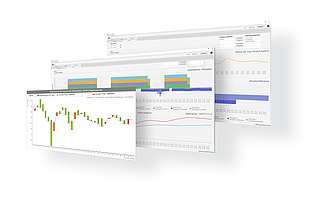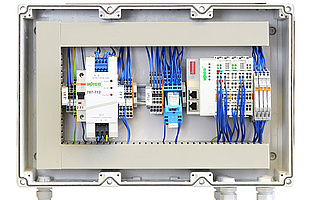Operational plant optimization
with AI forecast-based direct marketing
Actually, plant optimization is a simple task. With surpluses, you can achieve either additional revenues when electricity prices are high and lower consumption costs when electricity prices are low. Actually. But when is the right time for either of these two actions? When can plants do this without neglecting actual tasks? And how do you adjust the timetable to your plant in advance?
The keyword are: first optimize and then profit
The solution: SE²OPTIMIZER
For cost-cutting and revenue-increasing plant operation, the SE²OPTIMIZER is a demand side management solution that independently optimizes all the prosumers of energy generation and production plants and thus makes unused flexibilities economically viable.
The intelligent SE²OPTIMIZER is installed on-site at the plant, creates locally the target schedules based on the exchange price forecasts, and can be connected to virtually any trading platform for subsequent marketing.
Whether plant operation is optimized for self-generated power or for electricity prices, a switch that can be made at any time, the final decision always lies with the operator. Total control of the plant and all critical operating data always remains with the operator thanks to the locally performed optimization process.
Advantages AVAT SE²OPTIMIZER
- AI-based module for demand forecasts
- Operation optimized for own power and electricity prices
- Plant sovereignty remains with the operator at all times
- Sensitive data remains on the system at all times
- You can choose the marketer you prefer
- Modularly expandable into a complete VPP solution
You want to bundle several plants and control them flexibly? Then our control system for virtual power plants will be used as a higher-level control. The SE²DIRECTOR act as a communication interface fine-tuning of all systems and provides a secure gateway to direct marketers.
Cost-effective, holistic and expandable:
plant optimization directly on site
Besides energy costs, other costs such as personnel and process costs are included in the optimization. The algorithm determines the most cost-effective way forward across sectors for the specified period based on the interaction of producers, storage systems and consumers. The total overall cost optimization of up to 25% is then achieved by shifting the flexibly deployable electricity consumers and producers into more economical periods.
Not only the operational data remain within the company, the operator also determines the degree of automation at all times. Changing the flexible operating times of the systems and accepting, rejecting, or individually adapting the suggested optimized system schedules is possible at any time.
Energy suppliers and producers
To balance the power grid, grid operators and energy suppliers rely heavily on flexible storage options, load management and power reserves. A more targeted approach to operation contributes to a better balance between electricity consumption and generation. Especially with respect to heat supply, it makes sense to combine power-consuming units with power generators to a virtual power storage system. Just like in forecast-based generation and load management, the units are then optimized based on spot market prices. This is particularly suitable for district heating grids and properties with year-round heating requirements such as indoor swimming baths or hospitals.
Industrial plants
The flexibility of the SE²OPTIMIZER is also demonstrated in the integrability of various plant types: whether thermal processes (heaters, furnaces, etc.), mechanical processes with storages or warehouses (mills, injection molding machines, etc.) or industrial processes (chemical conversion processes, fermentation plants, etc.). A wide range of interfaces (I/O, Modbus, Profibus, etc.) can be used for system control depending on the desired degree of automation. Many plants, even existing ones, can therefore be used in a time flexible manner with very little effort and can easily be utilized for energy cost efficiency - the production goals always remain the priority.




